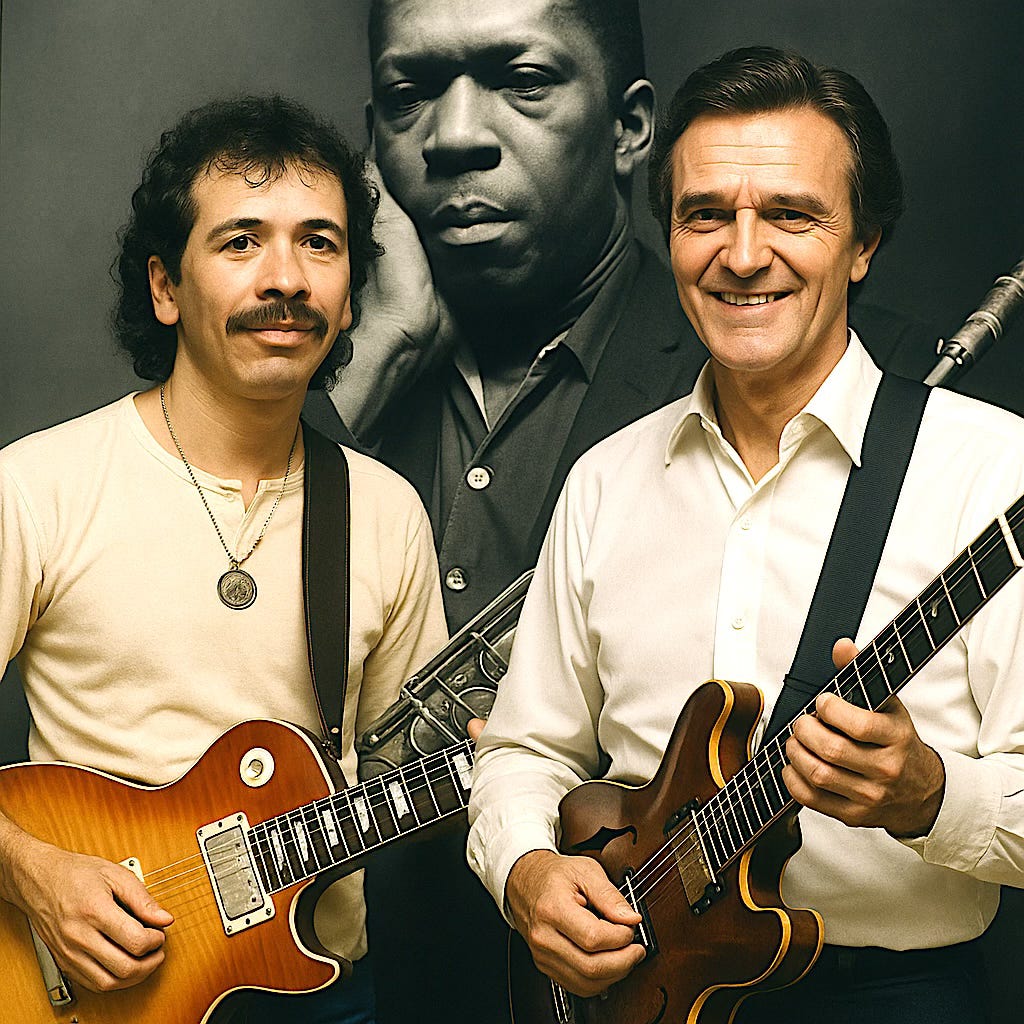In 1964, John Coltrane stepped into Rudy Van Gelder’s studio in Englewood Cliffs, New Jersey, and offered a prayer to the universe. That prayer became A Love Supreme—a four-part suite of devotion, humility, and sound. No lyrics. No ego. Just breath and spirit and a four-note mantra: A Love Supreme.
Nine years later, in 1973, two guitarists—Carlos Santana and John McLaughlin—entered Columbia’s studios in San Francisco and New York. They didn’t just pick up where Coltrane left off. They set it ablaze.
Their album, Love Devotion Surrender, is a musical act of worship, a spiritual initiation ceremony soaked in distortion and divine fire. It’s a tribute not only to Coltrane but to their shared spiritual teacher, Sri Chinmoy, whose teachings infused every note they played. Santana had just received the spiritual name Devadip. McLaughlin was already deep into the teachings of Chinmoy, and his Mahavishnu Orchestra had been tearing holes in the space-time fabric of jazz fusion.
Where Coltrane whispered devotion, Santana and McLaughlin screamed it into the sky.
These are two versions of the same spiritual intent—but expressed in opposite emotional languages.
Coltrane’s A Love Supreme is a sacred meditation.
It opens with a gentle four-note bass riff—A Love Supreme—chanted over and over like a mantra.
McCoy Tyner’s piano comps like waves washing against a shore.
Elvin Jones on drums doesn’t keep time; he invokes thunder.
It’s a suite in four movements: “Acknowledgement,” “Resolution,” “Pursuance,” and “Psalm.”
The final movement is a literal transcription of Coltrane’s poem, played through his horn—every word transformed into breath and tone.
This is music as stillness. A humble offering. A vow of purity.
By contrast, Santana and McLaughlin’s Love Devotion Surrender is an ecstatic firewalk.
It begins with their own take on “A Love Supreme”—same mantra, but this time it roars. Two guitars duel, harmonize, scream in harmony.
“The Life Divine” is a full-body exorcism—guitar, organ (by the great Larry Young), and Billy Cobham’s drums swirl in a vortex of rhythmic intensity.
“Let Us Go Into the House of the Lord” becomes a gospel-rock meditation, refracted through a prism of jazz-fusion transcendence.
Even “Naima,” Coltrane’s tender ballad, is reimagined—not with romantic nostalgia, but reverent fire.
This is music as surrender to ecstatic vision.
The Band That Lit the Match
The personnel on Love Devotion Surrender reads like a who’s who of spiritual fusion:
Carlos Santana – Guitar (flame)
John McLaughlin – Guitar (lightning)
Larry Young (Khalid Yasin) – Organ (cosmic current)
Billy Cobham – Drums (controlled chaos)
Doug Rauch – Bass (earthquake)
Don Alias – Percussion (pulse)
Mike Shrieve – Drums (Santana’s heartbeat)
Recorded in February 1973, the sessions often began with meditation. This wasn’t a jam session—it was a spiritual practice, a sonic offering to the Absolute.
Stillness vs. Fire
If Coltrane was a monk blowing prayers into a smoky void, Santana and McLaughlin were shamans riding lightning bolts.
Coltrane reaches inward—searching for God in silence, restraint, and melodic devotion.
Santana and McLaughlin reach upward—fingers ablaze, strings ringing out into the cosmos.
Both are sincere. Both are holy. But the energy is unmistakably different. One asks you to sit still and breathe. The other pulls you to your feet and dares you to dance into the fire.
Final Thoughts: What Path Calls You?
Love Devotion Surrender is not easy listening. It doesn’t want to be background music. It’s volcanic, ecstatic, and sometimes overwhelming. But it’s honest. And if you’ve ever stood at the edge of your own transformation—shaken, burning, unsure—you may find that this album speaks the language of your soul.
Coltrane gave us the silent vow.
Santana and McLaughlin gave us the sacred scream.
Either way, the destination is the same.
Love.
Devotion.
Surrender.
Which path do you take—silence or fire?
Let me know in the comments.
And if you’ve never heard Love Devotion Surrender, listen with your whole body. It’s not just an album.
It’s a test of your spiritual voltage.
Listen to “A Love Supreme.”
Listen to “Naima.”
- - - -
Until we meet again, let your conscience be your guide.



It would be Coltrane for me. In my 50+ years of listening, the explosive pyrotechnics of genius guitar players often grew beyond my absorption capacity, and that happens a bit with "A Love Supreme" here.
Although I love the Indian influence coming through from McLaughlin, sounding like Ravi Shankar at times. This beautifully befits the context, as Coltrane admired Indian music, and met Ravi Shankar in 1964. Had they met a bit earlier, Ravi Shankar might have been an incredible addition to the line-up in the making of Coltrane's Love Supreme. I'm just dreaming here!
All of Coltrane's sound-making provides complex sets of intonations, which evoke movements, facial expressions, things that cannot be expressed in words per se.
This is why I was astonished to learn (16 years ago or so) that Anne Teresa De Keersmaeker had created a choreography to A Love Supreme. I went to see it live. It was the longest lasting non-stop immersion in goose-bumps and simultaneous laughter and tears I ever experienced.
To me De Keersmaeker had succeeded in matching the movements to the music.
This short clip shows the start. After 48 seconds of silence, Elvin comes in with the big Chinese cymbal:
https://youtu.be/LwU8C27C78o?si=ymYJRI5ah5i93dpN
I tried so hard to get into this album, but couldn't get past the first five minutes. It stayed in my LP collection for years, and didn't leave my shelf until (like an idiot) I gave all my lp's away and switched to cd's.